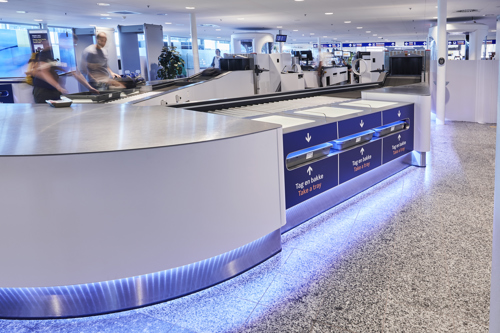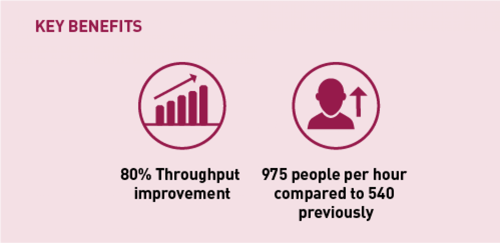With passenger numbers rising year–on-year, Denmark’s Aalborg Airport is continuing to leverage the latest technology to increase the speed and efficiency of its security checkpoints. The latest phase in this impressive transformation was the introduction of intelligent lanes which has improved throughput by a further 80% and made an equally positive impact on the passenger experience. Smiths Detection and its Danish partner Houlberg Instrumentering were chosen to deploy advanced iLanes – having also supported an earlier upgrade to ECAC EDS CB C2 approved equipment, making Aalborg the first airport in Denmark to implement that particular technology.
Offering a regional gateway to the rest of the world, Aalborg is Denmark’s third largest airport. Having developed significantly over the last 11 years, work continues on meeting all growth potentials and delivering better solutions. The airport’s expansion strategy focuses on developing appeal, creating new routes and attracting more passengers.
The passenger checkpoint is a key component in the overall plans and presents its own particular challenges – how to offer the highest levels of airport security and create an even more effective flow within existing space limitations. It was also important for the area to be aesthetically pleasing, offering a calm and pleasant environment for everyone.
Upgrading the existing HI-SCAN 6040 aTiX scanners to comply with ECAC EDS CB C2 eight months earlier had already significantly increased throughput. The ability to leave electronics in hand luggage during scanning reduced passenger preparation time and the demand for trays, creating a faster, simpler and more efficient baggage screening process. Eliminating the need for random trace detector searches also proved a major improvement for passengers and staff alike
The next phase of this technology-led redesign was to exchange conventional lanes for smart, Smiths Detection iLanes. Given the limited available space, Smiths Detection and Houlberg Instrumentering worked with the Aalborg team to design the best possible system and customised four iLanes accordingly. Developed to prevent bottlenecks and reduce queues to keep the process moving, they offer three main advances which address fundamental airport checkpoint issues.
First, the four lanes feature a total of 10 parallel divest stations, enabling multiple people to prepare simultaneously for baggage screening. Second there is an automatic tray return, rather than traditional manual transfer back to the start; and thirdly automatic diversion efficiently separates suspicious baggage from the main conveyor.

The advanced screening and management platform, Checkpoint.Evoplus, integrates all the lanes into one network. It aggregates data from across the entire screening area to generate a full range of invaluable insights, making it easy to monitor performance metrics in real-time for faster and better decision-making. In addition, it supports directed search and ensures the network is ready to move to centralised screening as and when required.
Marcus Pedersen, a company specialising high-end furniture for airports and other public spaces, designed cladding for the lane with clean smooth lines to emphasise the direction and flow of the checkpoint. Clever use of lighting and graphics helps to guide people through the process. Overall, this simple and minimalistic design reinforces the intuitive, calm and seamless passenger experience.
Traditionally, checkpoint security procedures have proven frustrating for the travelling public with hold-ups right from the start. Now at Aalborg, parallel divestment gets the flow moving quickly and effectively. A high level of automation leaves operators free to focus on the travelling public and preparing them for security screening. Overall, the new checkpoint delivers improved productivity and throughput – around 975 people per hour compared to 540 previously – combined with a much better passenger experience.
Automated tray return ensures there is a continuous supply of trays arriving back at the divestment point. Any trays carrying items identified as suspicious are automatically diverted off the main (cleared) conveyor towards a secondary search area with no interruption to the central flow.
